外代无抬头海运提单和背面条款
- 格式:doc
- 大小:54.50 KB
- 文档页数:1
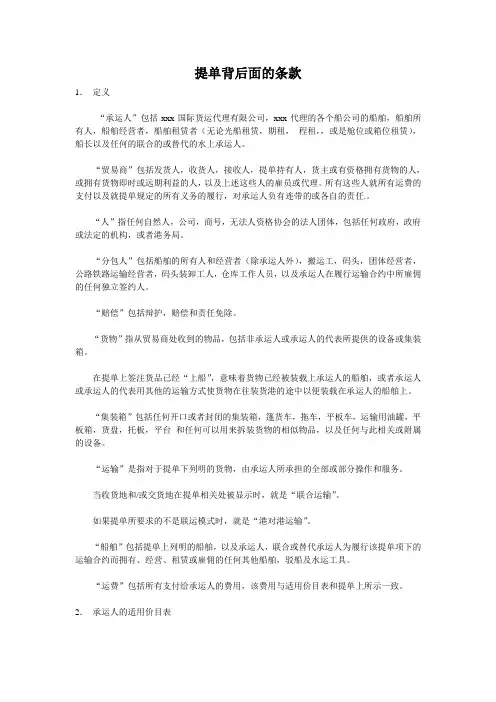
提单背后面的条款1.定义“承运人”包括xxx国际货运代理有限公司,xxx代理的各个船公司的船舶,船舶所有人,船舶经营者,船舶租赁者(无论光船租赁,期租,程租,,或是舱位或箱位租赁),船长以及任何的联合的或替代的水上承运人。
“贸易商”包括发货人,收货人,接收人,提单持有人,货主或有资格拥有货物的人,或拥有货物即时或远期利益的人,以及上述这些人的雇员或代理。
所有这些人就所有运费的支付以及就提单规定的所有义务的履行,对承运人负有连带的或各自的责任.。
“人”指任何自然人,公司,商号,无法人资格协会的法人团体,包括任何政府,政府或法定的机构,或者港务局。
“分包人”包括船舶的所有人和经营者(除承运人外),搬运工,码头,团体经营者,公路铁路运输经营者,码头装卸工人,仓库工作人员,以及承运人在履行运输合约中所雇佣的任何独立签约人。
“赔偿”包括辩护,赔偿和责任免除。
“货物”指从贸易商处收到的物品,包括非承运人或承运人的代表所提供的设备或集装箱。
在提单上签注货品已经“上船”,意味着货物已经被装载上承运人的船舶,或者承运人或承运人的代表用其他的运输方式使货物在往装货港的途中以便装载在承运人的船舶上。
“集装箱”包括任何开口或者封闭的集装箱,篷货车,拖车,平板车,运输用油罐,平板箱,货盘,托板,平台和任何可以用来拆装货物的相似物品,以及任何与此相关或附属的设备。
“运输”是指对于提单下列明的货物,由承运人所承担的全部或部分操作和服务。
当收货地和/或交货地在提单相关处被显示时,就是“联合运输”。
如果提单所要求的不是联运模式时,就是“港对港运输”。
“船舶”包括提单上列明的船舶,以及承运人,联合或替代承运人为履行该提单项下的运输合约而拥有、经营、租赁或雇佣的任何其他船舶,驳船及水运工具。
“运费”包括所有支付给承运人的费用,该费用与适用价目表和提单上所示一致。
2.承运人的适用价目表承运人的适用价目表上的条款于此同样适用。
请在这里特别关注与集装箱和运输工具逾期费有关的条款。

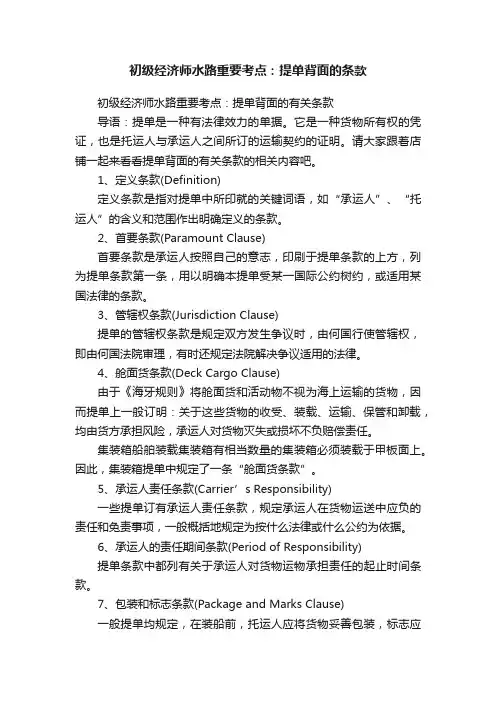
初级经济师水路重要考点:提单背面的条款初级经济师水路重要考点:提单背面的有关条款导语:提单是一种有法律效力的单据。
它是一种货物所有权的凭证,也是托运人与承运人之间所订的运输契约的证明。
请大家跟着店铺一起来看看提单背面的有关条款的相关内容吧。
1、定义条款(Definition)定义条款是指对提单中所印就的关键词语,如“承运人”、“托运人”的含义和范围作出明确定义的条款。
2、首要条款(Paramount Clause)首要条款是承运人按照自己的意志,印刷于提单条款的上方,列为提单条款第一条,用以明确本提单受某一国际公约树约,或适用某国法律的条款。
3、管辖权条款(Jurisdiction Clause)提单的管辖权条款是规定双方发生争议时,由何国行使管辖权,即由何国法院审理,有时还规定法院解决争议适用的法律。
4、舱面货条款(Deck Cargo Clause)由于《海牙规则》将舱面货和活动物不视为海上运输的货物,因而提单上一般订明:关于这些货物的收受、装载、运输、保管和卸载,均由货方承担风险,承运人对货物灭失或损坏不负赔偿责任。
集装箱船舶装载集装箱有相当数量的集装箱必须装载于甲板面上。
因此,集装箱提单中规定了一条“舱面货条款”。
5、承运人责任条款(Carrier’s Responsibility)一些提单订有承运人责任条款,规定承运人在货物运送中应负的责任和免责事项,一般概括地规定为按什么法律或什么公约为依据。
6、承运人的责任期间条款(Period of Responsibility)提单条款中都列有关于承运人对货物运物承担责任的起止时间条款。
7、包装和标志条款(Package and Marks Clause)一般提单均规定,在装船前,托运人应将货物妥善包装,标志应正确、清晰,用5cm或不小于5cm的字体标明货物的目的港,并必须保证字迹在交付货物时仍须清晰可辨。
8、留置权条款(Lien Clause)一般提单规定承运人对应收未收的运费、空舱费、滞期费以及其他费用,均可对货物或任何单证行使留置权,并有权出售或处理货物,以抵偿应收款项。
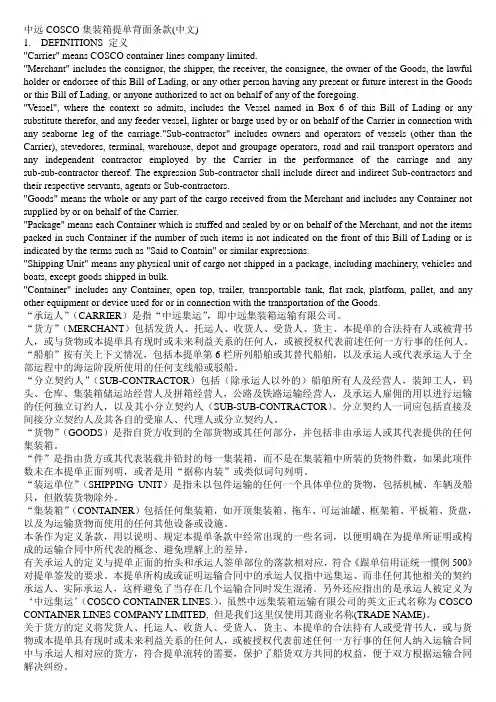
中远COSCO集装箱提单背面条款(中文)1. DEFINITIONS 定义"Carrier" means COSCO container lines company limited."Merchant" includes the consignor, the shipper, the receiver, the consignee, the owner of the Goods, the lawful holder or endorsee of this Bill of Lading, or any other person having any present or future interest in the Goods or this Bill of Lading, or anyone authorized to act on behalf of any of the foregoing."Vessel", where the context so admits, includes the Vessel named in Box 6 of this Bill of Lading or any substitute therefor, and any feeder vessel, lighter or barge used by or on behalf of the Carrier in connection with any seaborne leg of the carriage."Sub-contractor" includes owners and operators of vessels (other than the Carrier), stevedores, terminal, warehouse, depot and groupage operators, road and rail transport operators and any independent contractor employed by the Carrier in the performance of the carriage and any sub-sub-contractor thereof. The expression Sub-contractor shall include direct and indirect Sub-contractors and their respective servants, agents or Sub-contractors."Goods" means the whole or any part of the cargo received from the Merchant and includes any Container not supplied by or on behalf of the Carrier."Package" means each Container which is stuffed and sealed by or on behalf of the Merchant, and not the items packed in such Container if the number of such items is not indicated on the front of this Bill of Lading or is indicated by the terms such as "Said to Contain" or similar expressions."Shipping Unit" means any physical unit of cargo not shipped in a package, including machinery, vehicles and boats, except goods shipped in bulk."Container" includes any Container, open top, trailer, transportable tank, flat rack, platform, pallet, and any other equipment or device used for or in connection with the transportation of the Goods.“承运人”(CARRIER)是指“中远集运”,即中远集装箱运输有限公司。
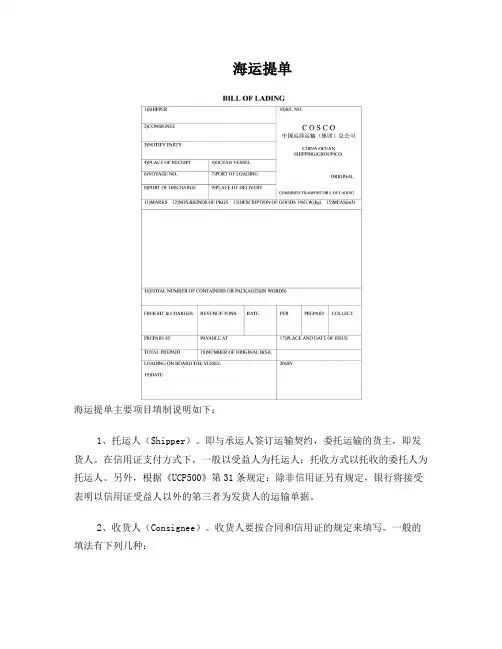
海运提单海运提单主要项目填制说明如下:1、托运人(Shipper)。
即与承运人签订运输契约,委托运输的货主,即发货人。
在信用证支付方式下,一般以受益人为托运人;托收方式以托收的委托人为托运人。
另外,根据《UCP500》第31条规定:除非信用证另有规定,银行将接受表明以信用证受益人以外的第三者为发货人的运输单据。
2、收货人(Consignee)。
收货人要按合同和信用证的规定来填写。
一般的填法有下列几种:(1)记名式:在收货人一栏直接填写上指定的公司或企业名称。
该种提单不能背书转让,必须由收货人栏内指定的人提货或收货人转让。
(2)不记名式:即在收货人栏留空不填,或填“To Bearer”(交来人/持票人)。
这种方式承运人交货凭提单的持有人,只要持有提单就能提货。
(3)指示式:指示式的收货人又分为不记名指示和记名指示两种。
不记名指示,是在收货人一栏填“To Bearer”,又称空白抬头。
该种提单,发货人必须在提单背面背书,才能转让。
背书又分为记名背书和不记名背书(空白背书)两种。
前者是指在提单背面填上“Deliver to ×××”“Endorsed to ×××”,然后由发货人签章;后者是发货人在背面不做任何说明只签章即可。
记名背书后,其货权归该记名人所有,而且该记名人不可以再背书转让给另外的人。
不记名背书,货权即归提单的持有人。
记名指示,是在收货人一栏填“To Order of Shipper”,此时,发货人必须在寄单前在提单后背书;另外还有凭开证申请人指示即L/C中规定“To Order of Applicant”,在收货人栏就填““To Order of ××× Co”;凭开证行指示,即L/C中规定“To Order of Issuing Bank”,则填“To Order of ×××Bank”。
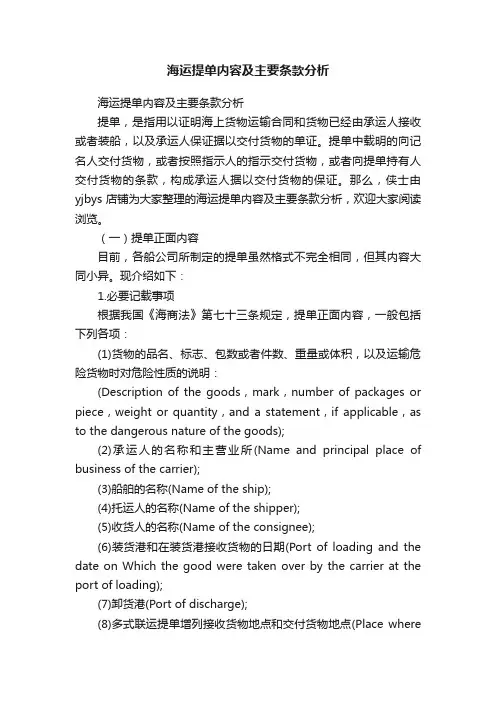
海运提单内容及主要条款分析海运提单内容及主要条款分析提单,是指用以证明海上货物运输合同和货物已经由承运人接收或者装船,以及承运人保证据以交付货物的单证。
提单中载明的向记名人交付货物,或者按照指示人的指示交付货物,或者向提单持有人交付货物的条款,构成承运人据以交付货物的保证。
那么,侠士由yjbys店铺为大家整理的海运提单内容及主要条款分析,欢迎大家阅读浏览。
(一)提单正面内容目前,各船公司所制定的提单虽然格式不完全相同,但其内容大同小异。
现介绍如下:1.必要记载事项根据我国《海商法》第七十三条规定,提单正面内容,一般包括下列各项:(1)货物的品名、标志、包数或者件数、重量或体积,以及运输危险货物时对危险性质的说明:(Description of the goods,mark,number of packages or piece,weight or quantity,and a statement,if applicable,as to the dangerous nature of the goods);(2)承运人的名称和主营业所(Name and principal place of business of the carrier);(3)船舶的名称(Name of the ship);(4)托运人的名称(Name of the shipper);(5)收货人的名称(Name of the consignee);(6)装货港和在装货港接收货物的日期(Port of loading and the date on Which the good were taken over by the carrier at the port of loading);(7)卸货港(Port of discharge);(8)多式联运提单增列接收货物地点和交付货物地点(Place wherethe goods were taken over and the place where the goods are to be delivered in case of a multimodal transport bill of lading);(9)提单的签发日期、地点和份数(Date and place of issue of the bill of loading and the number of originals issued);(10)运费的支付(Payment of freight);(11)承运人或者其代表的签字(Signature of the carrier or of a person acting on his behalf)。
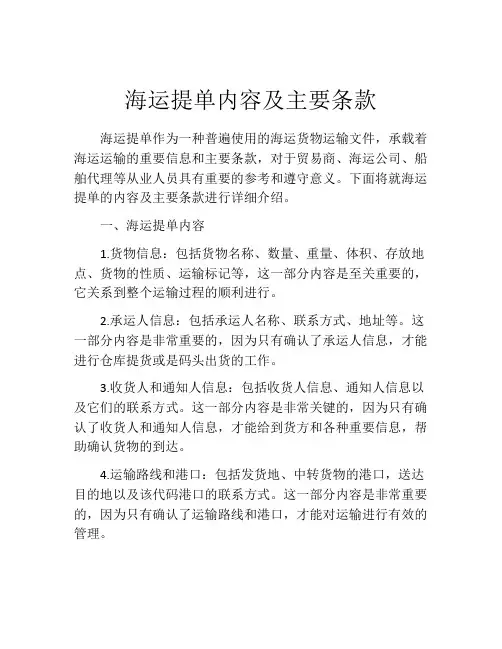
海运提单内容及主要条款海运提单作为一种普遍使用的海运货物运输文件,承载着海运运输的重要信息和主要条款,对于贸易商、海运公司、船舶代理等从业人员具有重要的参考和遵守意义。
下面将就海运提单的内容及主要条款进行详细介绍。
一、海运提单内容1.货物信息:包括货物名称、数量、重量、体积、存放地点、货物的性质、运输标记等,这一部分内容是至关重要的,它关系到整个运输过程的顺利进行。
2.承运人信息:包括承运人名称、联系方式、地址等。
这一部分内容是非常重要的,因为只有确认了承运人信息,才能进行仓库提货或是码头出货的工作。
3.收货人和通知人信息:包括收货人信息、通知人信息以及它们的联系方式。
这一部分内容是非常关键的,因为只有确认了收货人和通知人信息,才能给到货方和各种重要信息,帮助确认货物的到达。
4.运输路线和港口:包括发货地、中转货物的港口,送达目的地以及该代码港口的联系方式。
这一部分内容是非常重要的,因为只有确认了运输路线和港口,才能对运输进行有效的管理。
5.运费和付款:包括运费和付款方式,通常也会包括定期的付款周期。
这一部分内容关系到运输费用和财务交易的问题,因此具有重要的参考价值。
二、海运提单主要条款1.费用支付:这一部分主要关系到承运人的费用问题,包括货物的货款、费用以及各种附加费用的支付方式和周期。
2.装载和卸载:这一部分主要关系到卸载和装船时的工作和安全问题,包括货物放置方式、货物贮存条件以及货物的装卸方式等。
3.货物检验:这一部分主要关系到货物检验和确认问题,包括各种检验、质量确认以及试验等问题。
4.迟延责任:这一部分主要是规定了承运人对于货物迟延送达所负担的责任,包括返程、赔偿等。
5.船舶行程和运输路线:这一部分明确了转航、转包等问题,包括改运、交货等协议。
综上所述,对于海洋运输行业从业人员来说,掌握海运提单的内容及主要条款非常重要,它不仅关系到运输的顺利进行,而且还关系到各个环节的财务和交易方面。

海运提单海运提单主要项目填制说明如下:1、托运人(Shipper)。
即与承运人签订运输契约,委托运输的货主,即发货人。
在信用证支付方式下,一般以受益人为托运人;托收方式以托收的委托人为托运人。
另外,根据《UCP500》第31条规定:除非信用证另有规定,银行将接受表明以信用证受益人以外的第三者为发货人的运输单据。
2、收货人(Consignee)。
收货人要按合同和信用证的规定来填写。
一般的填法有下列几种:(1)记名式:在收货人一栏直接填写上指定的公司或企业名称。
该种提单不能背书转让,必须由收货人栏内指定的人提货或收货人转让。
(2)不记名式:即在收货人栏留空不填,或填“To Bearer”(交来人/持票人)。
这种方式承运人交货凭提单的持有人,只要持有提单就能提货。
(3)指示式:指示式的收货人又分为不记名指示和记名指示两种。
不记名指示,是在收货人一栏填“To Bearer”,又称空白抬头。
该种提单,发货人必须在提单背面背书,才能转让。
背书又分为记名背书和不记名背书(空白背书)两种。
前者是指在提单背面填上“Deliver to ×××”“Endorsed to ×××”,然后由发货人签章;后者是发货人在背面不做任何说明只签章即可。
记名背书后,其货权归该记名人所有,而且该记名人不可以再背书转让给另外的人。
不记名背书,货权即归提单的持有人。
记名指示,是在收货人一栏填“To Order of Shipper”,此时,发货人必须在寄单前在提单后背书;另外还有凭开证申请人指示即L/C中规定“To Order of Applicant”,在收货人栏就填““To Order of ××× Co”;凭开证行指示,即L/C中规定“To Order of Issuing Bank”,则填“To Order of ×××Bank”。
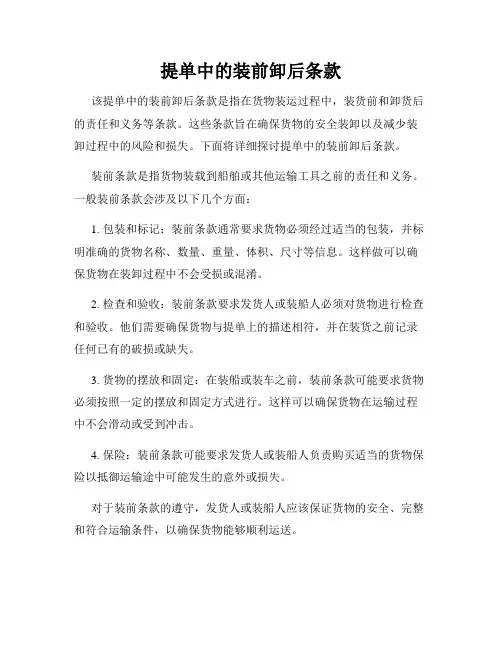
提单中的装前卸后条款该提单中的装前卸后条款是指在货物装运过程中,装货前和卸货后的责任和义务等条款。
这些条款旨在确保货物的安全装卸以及减少装卸过程中的风险和损失。
下面将详细探讨提单中的装前卸后条款。
装前条款是指货物装载到船舶或其他运输工具之前的责任和义务。
一般装前条款会涉及以下几个方面:1. 包装和标记:装前条款通常要求货物必须经过适当的包装,并标明准确的货物名称、数量、重量、体积、尺寸等信息。
这样做可以确保货物在装卸过程中不会受损或混淆。
2. 检查和验收:装前条款要求发货人或装船人必须对货物进行检查和验收。
他们需要确保货物与提单上的描述相符,并在装货之前记录任何已有的破损或缺失。
3. 货物的摆放和固定:在装船或装车之前,装前条款可能要求货物必须按照一定的摆放和固定方式进行。
这样可以确保货物在运输过程中不会滑动或受到冲击。
4. 保险:装前条款可能要求发货人或装船人负责购买适当的货物保险以抵御运输途中可能发生的意外或损失。
对于装前条款的遵守,发货人或装船人应该保证货物的安全、完整和符合运输条件,以确保货物能够顺利运送。
另一方面,卸后条款是指货物从船舶或其他运输工具上卸下后的责任和义务。
卸后条款通常包括以下要点:1. 卸货点的准备:卸后条款可能要求收货人或卸货人必须提前准备好卸货点,以确保货物能够及时、安全地卸下。
这包括提供适当的设备和工具,并确保卸货点符合安全规定。
2. 卸货的方式:卸后条款可能规定货物应按照特定的方式进行卸货,以确保货物的安全和完整。
例如,一些货物可能需要小心操作或以特定的顺序卸下,以避免损坏。
3. 观察和记录:卸后条款通常要求收货人或卸货人在卸货过程中观察和记录任何已有的破损或缺失。
这些观察和记录将作为后续索赔或纠纷解决的依据。
4. 货物的归属转移:卸后条款通常规定货物的归属从装船人或发货人转移到收货人或卸货人,意味着货物的风险和责任也同时转移。
通过遵守卸后条款,收货人或卸货人应确保货物在卸货过程中安全、完整地被接收,并尽快做好相关观察和记录工作。
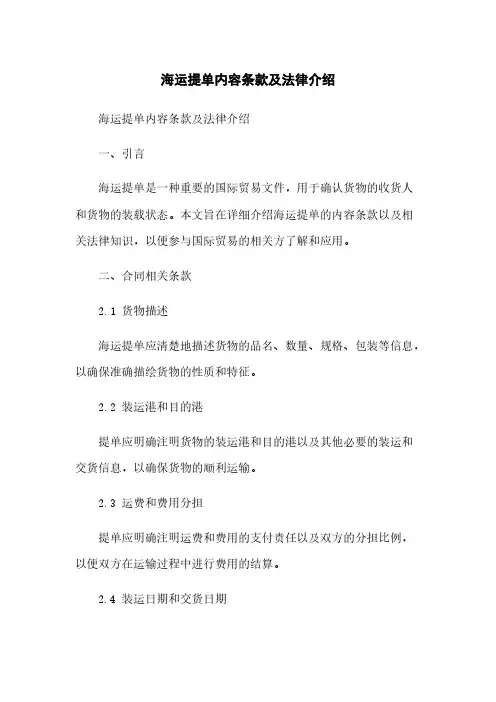
海运提单内容条款及法律介绍海运提单内容条款及法律介绍一、引言海运提单是一种重要的国际贸易文件,用于确认货物的收货人和货物的装载状态。
本文旨在详细介绍海运提单的内容条款以及相关法律知识,以便参与国际贸易的相关方了解和应用。
二、合同相关条款2.1 货物描述海运提单应清楚地描述货物的品名、数量、规格、包装等信息,以确保准确描绘货物的性质和特征。
2.2 装运港和目的港提单应明确注明货物的装运港和目的港以及其他必要的装运和交货信息,以确保货物的顺利运输。
2.3 运费和费用分担提单应明确注明运费和费用的支付责任以及双方的分担比例,以便双方在运输过程中进行费用的结算。
2.4 装运日期和交货日期提单应记录货物的装运日期和预计交货日期,以便双方能够掌握货物运输的时间节点。
三、货物运输条款3.1 装运方式提单应明确注明货物的装运方式,如整箱、拼箱或散货等,以确保货物能够按照合同约定的方式进行装运。
3.2 货物包装和标记提单应指明货物的包装和标记要求,以确保货物在运输过程中能够得到充分保护和辨识。
3.3 货物的运输和交付提单应详细描述货物的运输路线和交付方式,以确保货物能够按照约定的路径和方式进行运输和交付。
四、责任和赔偿条款4.1 货物损失和延误提单应明确规定对于货物损失和延误的责任以及赔偿的方式、标准和限制,以确保在货物运输过程中发生问题时相关方的权益得到保护。
4.2 重大事故和不可抗力提单应明确规定对于因重大事故或不可抗力造成的货物损失或延误的责任和赔偿方式,以确保在不可预见情况下相关方的权益得到保护。
五、申诉和争议解决条款5.1 申诉和索赔程序提单应明确规定申诉和索赔的程序和时限,以便在出现问题时相关方能够及时提出申诉和索赔。
5.2 争议解决方式提单应明确规定争议解决的方式,如仲裁、诉讼等,以确保争议能够得到有效解决。
附件:本所涉及附件如下:附件1:样品合同附件2:装箱单附件3:运输保险单法律名词及注释:1. 装运港:货物装上船或离开物流枢纽的港口。
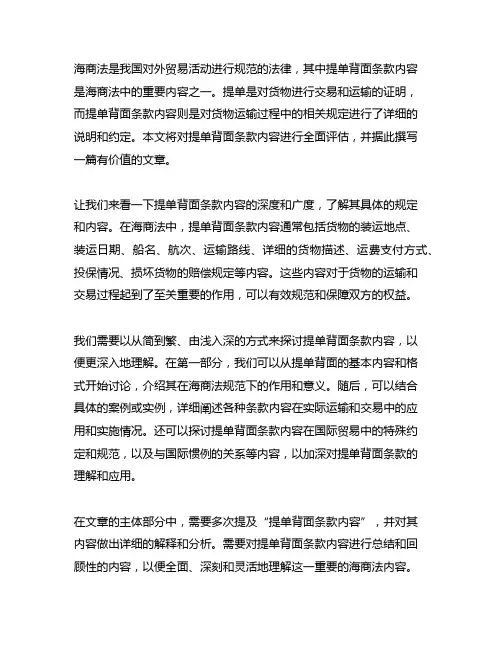
海商法是我国对外贸易活动进行规范的法律,其中提单背面条款内容是海商法中的重要内容之一。
提单是对货物进行交易和运输的证明,而提单背面条款内容则是对货物运输过程中的相关规定进行了详细的说明和约定。
本文将对提单背面条款内容进行全面评估,并据此撰写一篇有价值的文章。
让我们来看一下提单背面条款内容的深度和广度,了解其具体的规定和内容。
在海商法中,提单背面条款内容通常包括货物的装运地点、装运日期、船名、航次、运输路线、详细的货物描述、运费支付方式、投保情况、损坏货物的赔偿规定等内容。
这些内容对于货物的运输和交易过程起到了至关重要的作用,可以有效规范和保障双方的权益。
我们需要以从简到繁、由浅入深的方式来探讨提单背面条款内容,以便更深入地理解。
在第一部分,我们可以从提单背面的基本内容和格式开始讨论,介绍其在海商法规范下的作用和意义。
随后,可以结合具体的案例或实例,详细阐述各种条款内容在实际运输和交易中的应用和实施情况。
还可以探讨提单背面条款内容在国际贸易中的特殊约定和规范,以及与国际惯例的关系等内容,以加深对提单背面条款的理解和应用。
在文章的主体部分中,需要多次提及“提单背面条款内容”,并对其内容做出详细的解释和分析。
需要对提单背面条款内容进行总结和回顾性的内容,以便全面、深刻和灵活地理解这一重要的海商法内容。
总结部分可以对提单背面条款的作用和意义进行概括,强调其在货物运输和交易过程中的重要性,并提出相关的建议和思考。
我们需要共享对提单背面条款内容的个人观点和理解。
在我的观点中,提单背面条款内容是海商法中的重要保障措施,可以有效规范和保障货物运输和交易过程中的各种权益。
我认为在实际操作中,双方当事人需要充分了解和遵守提单背面条款的规定,以确保货物运输和交易的顺利进行,并有效应对可能出现的问题和风险。
经过对提单背面条款内容的全面评估和讨论,本文所撰写的有价值文章将对读者更加深入、全面地理解提单背面条款内容,并能够从中获取到实际操作中的指导和启发。
海运提单内容及主要条款海运提单内容及主要条款一、提单正面内容目前,各船公司所制定的提单虽然格式不完全相同,但其内容大同小异。
现介绍如下:1.必要记载事项根据我国《海商法》第七十三条规定,提单正面内容,一般包括下列各项:(1)货物的品名、标志、包数或者件数、重量或体积,以及运输危险货物时对危险性质的说明:(Description of the goods,mark,number of packages or piece,weight or quantity,and a statement,if applicable,as to the dangerous nature of the goods);(2)承运人的名称和主营业所(Name and principal place of business of the carrier);(3)船舶的名称(Name of the ship);(4)托运人的名称(Name of the shipper);(5)收货人的名称(Name of the consignee);(6)装货港和在装货港接收货物的日期(Port of loading and the date on Which the good were taken over by the carrier at the port of loading);(7)卸货港(Port of discharge);(8)多式联运提单增列接收货物地点和交付货物地点(Place where the goods were taken over and the place where the goods are to bedelivered in case of a multimodal transport bill of lading);(9)提单的签发日期、地点和份数(Date and place of issue of the bill of loading and the numberof originals issued);(10)运费的支付(Payment of freight);(11)承运人或者其代表的签字(Signature of the carrier or of a person acting on his behalf)。
海运提单的内容包括正文就背面条款两部分:一:提单正面内容一般包括:(1)托运人(SHIPPER):通常为信用证的受益人。
如果开证人为了贸易上的需求,要求做第三者提单(THIRD PARTY B/L),就是SHIPPER 不是信用证受益人,而是第三者做为SHIPPER.一般可以按要求制作。
(2)收货人(CONSIGNEE):如果要求记名提单,则可以填上具体收货人名称或收货公司的名称;如果是指示提单,则填为“指示”( ORDER)或“凭指示”(TO ORDER);如果需要在提单上列明指示人,则可根据不同要求,做成:“凭托运人指示”(TO ORDER OF SHIPPER),“凭收货人指示:(TO ORDER OF CONSIGNEE) 或”凭银行指示“(TO ORDER OF XX BANK);(3)被通知人(NOTIFY PARTY):这是船公司在货物到达目的港时发送到货通知的收件人,有时即为进口人。
在信用证项下的提单,如果信用证上对提单被通知人有具体规定时,则必须严格按信用证要求填写。
如果是记名提单或收货人指示提单,且收货人又有详细地址,则此栏可以不填。
如果是空白指示提单或托运人指示提单,则此栏必须填写列明被通知人名称及详细地址,否则船方就无法与收货人联系,收货人也不能及时报关提货。
甚至会因此超过海关规定的申报时间使货物被没收。
(4)提单号码(B/L NO):一般标注在提单右上角,以便于查找和联系用。
发货人向收货人发送装船通知(SHIPMENT ADVICE)时,也要列明船名和提单号。
(5)船名(NAME OF VESSEL):应填写装运货物的船名和航次。
(6)装货港(PORT OF LOADING):应填写实际装船港口的具体名称。
(7)卸货港(PORT OF DISCHARGE):应填写货物实际卸下的港口名称。
如果是转船,第一程船提单上的卸货港填转船港,收货人填二程船公司;第二程提单装货港填写上述转船港,卸货港填最后的目的港。
第五节提单的背面条款提单背面的条款,作为承托双方权利义务的依据,多则三十余条,少则也有二十几条,这些条款一般分为强制性条款和任意性条款两类。
强制性条款的内容不能违反有关国家的法律和国际公约、港口惯例的规定。
我国《海商法》第四章海上货物运输合同的第四十四条就明确规定:“海上货物运输合同和作为合同凭证的提单或者其他运输单证中的条款,违反本章规定的,无效。
”《海牙规则》第三条第八款规定:“运输契约中的任何条款、约定或协议,凡是解除承运人或船舶由于疏忽、过失或未履行本条规定的责任与义务,因而引起货物的或与货物有关的灭失或损害,或以本规则规定以外的方式减轻这种责任的,都应作废并无效。
” 上述的规定都强制适用提单的强制性条款。
除强制性条款外,提单背面任意性条款,即上述法规、国际公约没有明确规定的,允许承运人自行拟定的条款,和承运人以另条印刷、刻制印章或打字、手写的形式在提单背面加列的条款,这些条款适用于某些特定港口或特种货物,或托运人要求加列的条款。
所有这些条款都是表明承运人与托运人、收货人或提单持有人之间承运货物的权利、义务、责任与免责的条款,是解决他们之间争议的依据。
虽然各种提单背面条款多少不一,内容不尽相同,但通常都有下列主要条款:1.定义条款( Definition ) 定义条款是提单或有关提单的法规中对与提单有关用语的含义和范围作出明确规定的条款。
如中远提单条款第一条规定:货方( Merchant )包括托运人( Shipper )、受货人( Receiver )、发货人( Consignor )、收货人( Consignee )、提单持有人( Holder of B/L ),以及货物所有人( Owner of the Goods )。
在国际贸易的实践中,提单的当事人应该是承运人和托运人是毫无异议的。
但是,不论是以FOB还是CIF或CFR价格成交的贸易合同,按照惯例,当货物在装货港装船时,货物一旦越过船舷其风险和责任就转移到作为买方的收货人或第三者。
中远COSCO集装箱提单背面条款(中文)中远集团提单背面条款1. DEFINITIONS 定义“承运人”(CARRIER)是指“中远集运”,即中远集装箱运输有限公司。
“货方”(MERCHANT)包括发货人、托运人、收货人、受货人、货主、本提单的合法持有人或被背书人,或与货物或本提单具有现时或未来利益关系的任何人,或被授权代表前述任何一方行事的任何人。
“船舶”按有关上下文情况,包括本提单第6栏所列船舶或其替代船舶,以及承运人或代表承运人于全部运程中的海运阶段所使用的任何支线船或驳船。
“分立契约人”(SUB-CONTRACTOR)包括(除承运人以外的)船舶所有人及经营人,装卸工人,码头、仓库、集装箱储运站经营人及拼箱经营人,公路及铁路运输经营人,及承运人雇佣的用以进行运输的任何独立订约人,以及其小分立契约人(SUB-SUB-CONTRACTOR)。
分立契约人一词应包括直接及间接分立契约人及其各自的受雇人、代理人或分立契约人。
“货物”(GOODS)是指自货方收到的全部货物或其任何部分,并包括非由承运人或其代表提供的任何集装箱。
“件”是指由货方或其代表装载并铅封的每一集装箱,而不是在集装箱中所装的货物件数,如果此项件数未在本提单正面列明,或者是用“据称内装”或类似词句列明。
“装运单位”(SHIPPING UNIT)是指未以包件运输的任何一个具体单位的货物,包括机械、车辆及船只,但散装货物除外。
“集装箱”(CONTAINER)包括任何集装箱,如开顶集装箱、拖车、可运油罐、框架箱、平板箱、货盘,以及为运输货物而使用的任何其他设备或设施。
本条作为定义条款,用以说明、规定本提单条款中经常出现的一些名词,以便明确在为提单所证明或构成的运输合同中所代表的概念、避免理解上的差异。
有关承运人的定义与提单正面的抬头和承运人签单部位的落款相对应,符合《跟单信用证统一惯例500》对提单签发的要求。
本提单所构成或证明运输合同中的承运人仅指中远集运、而非任何其他相关的契约承运人、实际承运人,这样避免了当存在几个运输合同时发生混淆。
The follow are the conditions and exceptions hereinbefore referred to:1.D EFINTION. “Merchant” i ncludes the Shipper, the Receiver, the Consignor, the consignee, the Holder of the Bill of Lading and the Owner of the Goods.2.J URISDICTION. All disputes arising under and in connection with this Bill of Lading shall be settled in the flag – state of the ship, or otherwise in the place mutually agreed between the Carrier and the Merchant.3.P ARAMOUNT CLAUSE. This Bill of Lading shall be subject to the Hague Rules contained in the International Convention for the Unification of Certain Rules of law Relating to Bills of Lading, dated at Brussels the 25th August 1924, or the corresponding legislation of the flag state of the ship. If the stipulation of this Bill of Lading are wholly or partly contrary there to, this Bill of Lading shall be read as if such stipulation or part thereof, as the case may be, were deleted.4.P ERIOD OF RESPONSIBILITY. The responsibility of the Carrier shall commence from the time when the goods are loaded on board the vessel and shall cease when they are discharged from the vessel.The Carrier shall not be liable for loss of or damage to the goods before loading and after discharging from the vessel, howsoever such loss or damage arises.5.P ACKING AND MARKS. The Merchant shall have the goods properly packed and accurately and clearly marked before shipment. The port of destination of the goods should be marked in letters not less than 5 cm high, in such a way as will remain legible until their delivery, All fines and expenses arising from insufficiency or inadequacy of packing or marks shall be borne by the Merchant.6.F EIGHT AND OTHER CHARGES. (1) Advance freight together with other charges is due onshipment. If not prepaid. Though stipulated, the freight and other charges shall be paid by the Mer- chant plus 5% interest per annum running from the date of notification for their payment,If the cargo shipped are perishables, low cost goods, live animals, deck cargo or goods for which there is no Carrier’s agent at the port of destination, the freight for such cargo and all related charges shall be paid at the time of shipment.Freight payable at destination together with other char ges is due on vessel’s arrival.Advance freight and/or freight payable at destination shall be paid to the Carrier in full, and non-returnable and non-deductable irrespective of whatever loss or damage may happen to vessel and cargo or either of them.(2) All dues, taxes and charges or any other expenses in connection with the goods shall be paid bythe Merchant.7.INCORRECT STATEMENT. The Carrier is entitled, at port of shipment and /or port of destination, to verify the quantity, weight, measurement and/or contents of such goods as declared by the Merchant. If the weight, measurement and/or contents of such goods as stated in the Bill of Lading turned out to be inconsistent with that of the goods actually loaded, and the freight paid falls short of the amount which would have been due if such declaration had been correctly given the Carrier is entitled to collect from the Merchant as liquidated damages to the Carrier double the amount of difference between the freight for the goods actually shipped and that misstated.The Merchant shall be liable for loss of and damage to the vessel and/or goods arising or resulting from inaccuracies in stating the description, quantity, weight, measurement or contents of the goods and shall indemnify the Carrier for the costs and expenses in connection with weighing, measuring and checking such goods.8.LOADING, DISCHARGING AND DELIVERY. The goods shall be supplied and taken deliveryof by the Owner of the goods as fast as the vessel can take and discharge them, without interruption, by day and if required by Carrier also by night, Sundays and holidays included, notwithstanding any custom of the port to the contrary and the Owner of the goods shall be liable for all losses or damages including demurrage incurred in default thereof.Discharge may commence without previous notice, If the goods are not taken delivery of by the Receiver from alongside the vessel without delay, or if the Receiver refuses to take delivery of the goods, or in case there are unclaimed goods, the Carrier shall be at liberty to land such goods on shore or any other proper places at the sole risk and expense of the Merchant, and theCarrier’s responsibility of delivery of cargo shall be deemed to have been fulfilled.Weighing on board is only allowed by special permission of the Carrier, including detention and extra costs of discharging, shall be for account of the Receivers or Consignees, notwithstanding any custom of the port to the contrary.If the goods are unclaimed during a reasonable time, or wherever the goods will become deteriorated decayed or worthless, the Carrier may, at his discretion and subject to his lien, and without any responsibility attaching to him, sell, abandon or otherwise dispose of such goods solely at the risk and expense of the Merchant.9.LIGHTERAGE.,Any lighterage in or off ports of loading or ports of discharge shall be for the ccount of the Merchant.10..LIEN. The Carrier shall have a lien on the goods and any document relating thereto for freight,dead freight, demurrage and any other amount payable by the Merchant, and for General Average contributions for whomsoever due and for the cost of recovering the same, and for this purpose shall have the right to sell or otherwise dispose of the goods. If on sale of the goods, the proceeds fail to cover the amount due and the cost and expenses incurred , the Carrier shall be entitled to recover the deficit from the Merchant.11.NOTICE OF LOSS OR DAMAGE, THIME BAR. Unless notice of loss or damage and thegeneral nature of such loss or damage be given in writing to the Carrier or his agent at the port ofdischarge before or at the time of the removal of the goods into the custody of the person entitledto delivery thereof under the contact of carriage, such removal shall be prima facie evidence ofthe delivery by the Carrier of the goods as described in the Bill of Lading. If the loss or damage isnot apparent, the notice must be given within three days of the delivery.The notice in writing neednot be given if the state of the goods has at the time of their receipt been the subject of joint survey or inspection.In any event the carrier and the vessel shall be discharged from all liability in respectof loss or damage unless suit is brought within one year after delivery of the goods or the datewhen the goods should have been delivered.In the case of any actual or apprehended loss or damage the Carrier and the Receiver shall give all reasonable facilities to each other for inspecting and tallying the goods.12.LIMITATION OF LIABILITY. All claims for which the Carrier may be liable shall be calculatedon the basis of the Merchant’s net invoice cost, p lus freight and insurrance premuim, if paid. In no event shall the Carrier be liable for any loss of possible profit or any consequential loss.The Carrier for any loss of or damage to the goods shall be limited to an amount not exceeding £100 per package or freight unit unless the value of the goods higher than the amount is declared in writing by the Shipper before receipt of the goods by the Carrier and inserted in this Bill of Lading and extra freight paid as required. If the actual value of the goods per package of per freight unit exceeds such value, the declared value shall nevertheless be deemed to be the declared value and the Carrier’s liability if any, shall not be the declared value and any partial loss or damage shall be adjusted pro rata on the basis of such declared value.13.FORWARDING, SUBSTITUTE OF VESSEL, THROUGH CARGO AND RANSHIPMENT.If necessary, the Carrier shall be at liberty to carry the goods to their port of destination by othervessel or vessels either belonging to the Carrier or other persons or by rail or other means oftransport proceeding either directly or indirectly to such port and to carry the goods or part of them beyond their port of destination, and to tranship, lighter, land and store the goods on shore or afloat and reship and forward same at the Carrier’s expenses but at Merchant’s risk. The responsibility of the Carrier shall be limited to the part of the transport performed by him on the vessel under hismanagement.14.DANGEROUS GOODS, CONTRABAND. (1) The Merchant undertakes not to tender fortransportation any goods which are of a dangerous, inflammable, radio-active, and/or any harmful nature without previously giving written notice of their nature to the Carrier and marking the goods and the container or other covering on the outside as required by any laws or regulations whichmay be applicable during the carriage.(2) Whenever the goods are discovered to have been shipped without complying with the subclause1 above or the goods are found to be contraband or prohibited by any laws or regulations of the portof loading, discharge or call or any place or waters during the carriage, the Carrier shall be entitled to have such goods rendered innocuous, thrown overboard or discharged or other wise disposed of at the Carrier’s discretion without compensation and the Merchant shall be liable for and indemnify the Carrier against any kind of loss, damage or liability including loss of freight, and any expenses directly or indirectly rising out of or resulting from such shipment.(3)If any goods shipped complying with the sub-clause (1) above become a danger to the ship orcargo, they may in like manner be rendered innocuous, thrown overboard or discharged or other wise disposed of at the Carrier’s discretion without compensation except to General Average, if any. 15.DECK CARGO, LIVE ANIMALS AND PLANTS. Cargo on deck, plants and live animals arereceive d, handled, carried, kept and discharged at Merchant’s risk and the Carrier shall not be liable for loss thereof or damage thereto.16.CARGO IN CONTAINERS. (1)Goods may be stowed by the Carrier or his agents or servants in containers and containers whether stowed aforesaid or received fully stowed may be carried on or under deck without notice. The Carrier’s liability for such carriage shall likewise be governed bythe terms and conditions of this Bill of Lading irrespective of Clause 15 hereof notwithstanding the fact that the goods are being carried on deck and the goods shall contribute to General Average and shall receive compensation in General Average. (2) If a container has not been filled, packed,stuffed or loaded by the Carrier, the carrier shall not be liable for loss of or damage to the contents and the Merchant shall indemnify the Carrier against any injury, loss, damage, liability or expense incurred by the Carrier if such injury, loss, damage, liability or expense has been caused by:1) the manner in which the container has been filled, packed, stuffed or loaded; or2) the unsuitability of the contents for carriage in containers; or3) the unsuitability or defective condition of the container which would have been apparent uponreasonable inspection by the Merchant at or prior to the time the container was filled, packed,stuffed or loaded.If a container which has not been filled, packed, stuffed or loaded by the Carrier is deliveredby the Carrier with the seal intact, such delivery shall be deemed as full and complete performance of the Carrier’s obligation hereunder and the Carrier shall not be liab le for any loss of or damage to the contents of the container, The Shipper shall inspect containers before stuffing them and the use of the containers shall be prima facie evidence of their being sound and suitable for use.17.REFRIGERATED GOODS. Before loading goods in any insulated space, the Carrier shall, inaddition to the Class Certificate, obtain the certificate of the Classification Society’s Surveyor orother competent person, stating that such insulated space and refrigerating machinery are in the opinion of the surveyor or other competent person fit and safe for the carriage and preservation ofrefrigerated goods, The aforesaid certificate shall be conclusive evidence against the Merchant.Receivers have to take delivery of refrigerated cargo as soon as the vessel is ready to deliver, otherwise the Carrier shall land the goods at the wharf at the Merchant’s risk and expense.18.TIMBER. Any statement in this Bill of Lading to the effect that timber has been shipped “Inapparent good order and condition” does not involve any admission by the Carrier as to theabsence of stains, shakes, splits holes or broken pieces, for which the Carrier accepts noresponsibility.19.IRON AND STEEL. Every piece of Iron and Steel is to be distinctly and permanently marked with oil paint and every bundle securely fastened, distinctly and permanently marked with oil paint and metal tagged, by the Merchant, so that each piece or bundle can be distinguished at port of discharge. If the Merchant fails to meet the aforesaid requirements, the Carrier, shall neither be responsiblefor correct delivery nor liable for expenses arising therefrom.20.BULK CARGO, GOODS TO MORE THAN ONE CONSIGNEE. (1) As the Carrier has noreasonable means of checking the weight of bulk cargo, any reference to such weight in this Bill of Lading shall be deemed to be for reference only, but shall constitute in no way evidence against the Carrier(2)Where bulk Cargo or goods without marks or cargo with the same marks are shipped to morethan one Consignee, the Consignees or owners of the goods shall jointly and severally bear any expense or loss in dividing the goods or parcels into pro rata quantities and any deficiency shall fall upon them in such proportion as the Carriers, his servants or agents shall decide.21.HEAVY LIFTS AND AWKWARD CARGO. Any one piece or package of cargo weighs 2000kilos or upwards and any awkward cargo with a length of 9 meters or upwards must be clearly andboldly marked with the weight and/or dimensions and/or length by the Shipper and shall be loaded and discharged by shore crane or otherwise at the ship’s option and at the risk and expense of theMerchant. If any damage, loss or liability to the ship, lighter, wharf, quay, cranes, hoisting tackle, or whatsoever or to whomsoever occurs owing to the lack of statement or mis – statement of weight,measurement or length, the Merchant shall be responsible for such damage, loss or liability.22.FUMIGATION. In the event of fumigation of goods on board for whatever reason, the Carrier shall not be liable for damage to goods wi thout actual proof of the Carrier’s negligence which shall not be presumed against him, and all expenses incurred are for Merchant’s account.23.OPTION. The port of discharge for optional goods must be declared to the vessel’s agents at thefirst of the optional ports named in the option not later than 48 hours before the vessel’s arrivalthere. In the absence of such declaration the Carrier may elect to discharge at the first or anyoptional port and the contract of carriage shall then be considered as having been fulfilled. Any option must be for the total quantity of goods under this Bill of Lading.24.GENERAL AVERAGE AND NEW JASON CLAUSE. (1)General average shall be adjusted.Stated and settled according to the York – Antwerp Rulos, 1974, at any port or place at thecarrier’s option. In the event of accident, danger, damage or disaster before or after thecommencement which, or for the consequence of which the Carrier is not responsible, by statutecontract or otherwise, the goods, Shippers, Consignees or Owners of the goods shall contribute with the Carrier in General Average to the payment of any sacrifices, losses or expenses of a GeneralAverage nature that may be made or incurred and shall pay salvage and special charges incurred in respect of the goods, If a salving ship is owned or operated by the Carrier, salvage shall be paid for as fully as if the said salving ship or ships belonged to strangers. Such deposit as the Carrier of his agents may deem sufficint to cover the estimated contribution of the goods, and any salvage andspecial charges thereon shall, if required, be made by the goods, Shippers, Consignees or Owners of the goods to the Carrier before delivery.25.BOTH TO BLAME COLLISION CLAUSE. If the vessel comes into collision with anothervessel as a result of the negligence of the other vessel and any act, neglect or default of the master,mariner, pilot or of the servants of the Carrier in the navigation or in the management of the vessel, the owners of the goods carried hereunder will indernmify the Carrier against all loss or liability to the other or non-carrying vessel or her Owners in so far as such loss or liability represents loss ofor damage to or any claim whatsoever of the Owners of said goods paid or payable by the other or non-carrying vessel or her Owners to the Owners of said goods and setoff, recouped or recoveredby the other or non-carrying vessel or her Owners as part of their claim against the carrying ship or Carrier. The forgoing provisions shall also apply where the Owners, operators or those in charge of any vessel or vessels or objects other than, or in addition to, the colliding vessels or objects are atfault in respect of a collision, contact stranding or other accident.26. WAR, QUARANTINE, ICE, STRIKES, CONGESTION ETC. Should it appear that war,blockade, pirate, epidemics, quarantine, ice, strikes, congestion and other causes beyond theCarrier’s control would prevent the vessel from safely reaching the port of destination and/ordischarging the goods thereat, the Carrier is entitled to discharge the goods at the port of loading or any other safe and convenient port and the contract of carriage shall be deemed to have beenfulfilled. Any extra expenses incurred under the oforasaid circumstances shall be borne by theMerchant.。